DACF Home → Bureaus & Programs → Maine Natural Areas Program → Communities, Plants, and Animals → Invasive Plants → Perennial Pepperwort
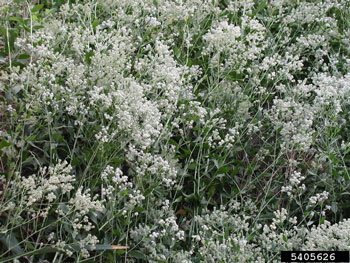 Perennial pepperweed, Bonnie Million, National Park Service, Bugwood.org
Perennial pepperweed, Bonnie Million, National Park Service, Bugwood.org
Perennial Pepperweed
(Perennial pepperwort)
Lepidium latifolium
2019 Status in Maine: Localized. Severely Invasive.
Description: Perennial, multi-stemmed herb 1-5' tall. Leaves: Basal leaves are stalked, up to 12" long and 3" wide. Stem leaves are significantly smaller, alternate, and lanceolate to oblong. Edges are entire to weakly serrate. Sessile to stalked. Flowers: Small, 4-petaled white flowers occur in dense clusters near stem tips from summer to fall. Fruit: Very small pods, 1⁄10" long; each pod contains 2 seeds. Roots: Base of stem is semi-woody; roots form woody crown at soil surface. Roots can both creep and grow deep, depending on soil type. New plants can arise from small sections of root.
Native range: Southeastern Europe, Southwestern Asia. How arrived in U.S.: Contaminant in agricultural seeds.
Reproduction: Mostly by seed, but also vegetatively by root fragments.
Habitat: Commonly found in meadows, wetlands, stream and river shores, sandy beaches, dunes, and salt marshes. Tolerates wide range of soil types and moisture, including flooding. Studies indicate it can act as a salt pump, pulling up salt ions from deep soil layers and depositing them on the surface. Changes in topsoil salinities can dramatically alter species composition and diversity.
Similar native species: None.
Similar non-native species: Other weedy mustards, though in general they are much smaller. Superficially, the clusters of small white flowers on tall stalks of common valerian (Valeriana officinalis), Queen Anne's lace (Daucus carota), or angelicas (Angelica spp.) may resemble perennial pepperweed, but leaves are very different.
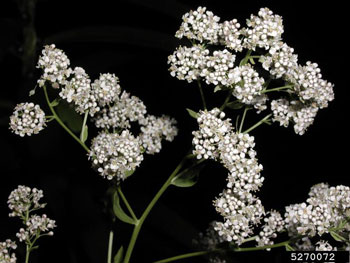 Perennial pepperweed flowers, Leslie J. Mehrhoff, University of Connecticut, Bugwood.org
Perennial pepperweed flowers, Leslie J. Mehrhoff, University of Connecticut, Bugwood.org
Fact Sheets and Identification Links
- New Hampshire Coastal Program, Department of Environmental Services, Identification Video (5:27)
- NH Invasives Academy Perennial Pepperweed Identification and Control Video (1:16)
- University of Wisconsin Extension, Identification Video (2:59)
- Go Botany page for Lepidium latifolium
Control Methods
Plants may be difficult to hand pull, depending on depth of rootstock*. Root fragments can regenerate. Sheep grazing is effective in infestations mixed with other plants. High volume foliar applications of glyphosate† result in fair to poor control in dense stands; consider spring grazing or mowing dense patches and then applying herbicide to re-growth. Best application time for herbicides is flowerbud to early flowering stage. Herbicides with more residual activity, such as imazapyr, imazapic, or metsulfuron methyl can increase efficacy, but should be prescribed and applied only by a licensed applicator, with care to minimize damage to non-target species. Special rules apply to herbicide use in or near wetlands and water bodies - consult the Maine Board of Pesticides Control.
* Correctly dispose of all plant parts↵ † Follow all label directions when using herbicides↵Control Technique Video Demonstrations
Please email invasives.mnap@maine.gov if you have questions about invasive species in Maine
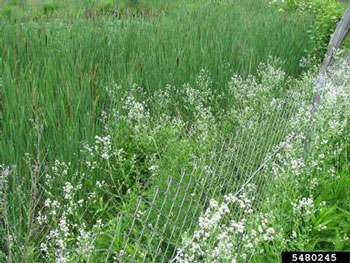 Perennial pepperweed infestation, Leslie J. Mehrhoff, University of Connecticut, Bugwood.org
Perennial pepperweed infestation, Leslie J. Mehrhoff, University of Connecticut, Bugwood.org
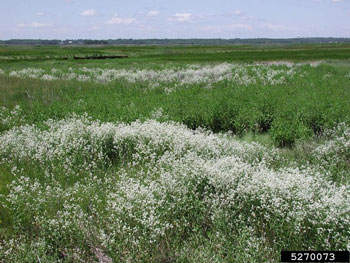 Perennial pepperweed infestation, Leslie J. Mehrhoff, University of Connecticut, Bugwood.org
Perennial pepperweed infestation, Leslie J. Mehrhoff, University of Connecticut, Bugwood.org
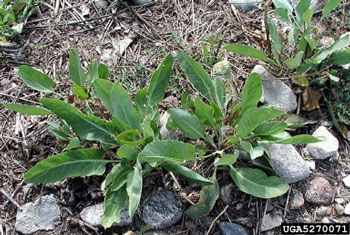 Perennial pepperweed rosette, Leslie J. Mehrhoff, University of Connecticut, Bugwood.org
Perennial pepperweed rosette, Leslie J. Mehrhoff, University of Connecticut, Bugwood.org